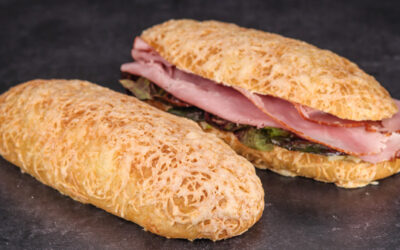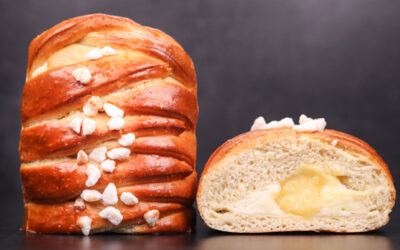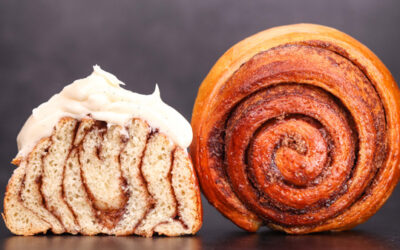Yudane is one of the best methods for making bread dough extra light and soft. And if there is one type of bread that should be extra soft it is the humble cinnamon roll.
Someone suggested this to me recently and I was kicking myself because I had not thought of it sooner myself. I’m lucky to have curious viewers who throw some great ideas at me every now and then.
If you are unfamiliar with yudane, then check out the video I made about it. You can find it in the Principles of Baking playlist.
In short, part of the flour of a recipe is mixed with boiling water. The hot water gelatinizes the starch in the flour. The mix is then cooled down and added to the dough. The gelatinized yudane makes the dough super light and soft. It works especially well when combined with some enrichments like egg, sugar, and butter.
Oh, and not to forget the other crucial part of this recipe – the frosting. Cream cheese, vanilla, butter, and sugar. I could eat this stuff with a spoon and suffer the regret later. It is the ultimate combo which makes these the ultimate cinnamon rolls.
This recipe makes 6 rolls. To make more simply multiply all the ingredients.
Watch the video down below for detailed instructions.
Ingredients
For the yudane –
100g (3.5oz) white bread flour
100g (3.5oz) boiling water
For the dough –
200g (7oz) white bread flour
60g (2.1oz) cold water*
30g (1oz) sugar
4g (0.14oz) instant dry yeast or 4.8g (0.17oz) active dry yeast or 12g (0.42oz) fresh yeast
5g (0.17oz) salt
60g (2.1oz) softened butter
1 egg yolk
Use the leftover egg white for glazing before baking
*To learn more about dough temperature control click here.
The flour I use has a protein content of 13%. If your flour is weaker, then you may need to lower the hydration.
If you are using active dry yeast, then you may need to let it sit in the water for 10 minutes before adding the other ingredients or else it could take a lot longer to raise the dough.
If you are curious about why the dough contains butter, egg, and sugar, click the links to learn more about the effects those ingredients have on bread dough.
For the filling –
70g (2.45oz) sugar
6g (0.2oz) cinnamon
40g (1.4oz) softened butter to brush
For the frosting –
160g (5.65oz) icing sugar
50g (1.75oz) full fat cream cheese
20g (0.7oz) softened butter
6g (0.2oz) vanilla paste
2g (0.07oz) water to adjust the consistency if necessary. I ended up not using it.
Method
- Make the yudane. Mix the flour and boiling water until there is no dry flour left. Cover and leave to cool down completely. You can use the yudane to help control the final dough temperature. If your kitchen is warm, then refrigerate it. If your kitchen is cold, then keep it at room temperature.
- Make the dough. In a large bowl combine the water, yeast, salt, sugar, and egg yolk. Mix well to dissolve the salt and sugar, and to hydrate the yeast.
- Add the yudane and the flour. Mix to a dough.
- Tip the dough out on the table and knead it for 3 minutes.
- Tear in the butter and continue kneading using the slap & fold kneading method. Once the dough comes together you can switch back to the regular kneading method. Knead the dough for 6 minutes after tearing in the butter. *Desired dough temperature 25C – 26C (77F – 79F). If your dough is warmer, then it will ferment more rapidly. If it is cooler, then it will take longer. Adjust proofing time accordingly.
- Cover and ferment for 1 hour.
- Fold.
- Ferment for 1 more hour.
- Roll the dough out. Brush with butter and sprinkle with cinnamon sugar. Roll it up and seal the edge.
- Cut the roll into 6 pieces. Tuck the end piece of the dough underneath each roll.
- Place on a non-stick paper lined tray.
- Final proof will take around 2 hours. *During the final hour of fermentation preheat the oven to 160C (320F) fan on.
- Brush the rolls the egg white and bake for 23 minutes.
- Leave to cool down completely before topping with the frosting.
Keep in mind that the conditions in each kitchen are different, so fermentation times may vary for you. It is up to the baker to control the bread and react accordingly.
Your oven may be different too, so your baking time may vary.
Watch the video here



